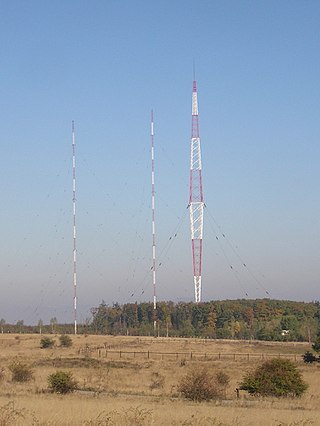Telecommunications in Botswana include newspapers, radio, television, fixed and mobile telephones, and the Internet.

Telecommunications in Bulgaria include radio, television, fixed and mobile telephones, and the Internet.
Telecommunications in Burkina Faso include radio, television, fixed and mobile telephones, and the Internet.
Telecommunications in Greenland include radio, television, fixed and mobile telephones, and the Internet.

Communications in Hong Kong includes a wide-ranging and sophisticated network of radio, television, telephone, Internet, and related online services, reflecting Hong Kong's thriving commerce and international importance.
This article provides an overview of telecommunications in Lithuania, including radio, television, telephones, and the Internet.
Communications in Malawi includes the country's postal, telephone, television, radio and internet services.
Telecommunications in Rwanda include radio, television, fixed and mobile telephones, and the Internet.
Telecommunications in Sudan includes fixed and mobile telephones, the Internet, radio, and television. Approximately 12 million out of 45 million people in Sudan use the Internet, mainly on smartphones and mobile computers.
Telecommunications in Tanzania include radio, television, fixed and mobile telephones, and the Internet available in mainland Tanzania and the semiautonomous Zanzibar archipelago.
Telecommunications in Trinidad and Tobago include radio, television, fixed and mobile telephones, and the Internet.

Telecommunications in Azerbaijan provides information about television, radio, fixed and mobile telephones, and the Internet in Azerbaijan. The Azerbaijan economy has been markedly stronger in recent years and, not surprisingly, the country has been making progress in developing ICT sector. Nonetheless, it still faces problems. These include poor infrastructure and an immature telecom regulatory regime. The Ministry of Communications and Information Technologies of Azerbaijan (MCIT), as well as being an operator through its role in Aztelekom, is both a policy-maker and regulator.
Portugal has a modern and flexible telecommunications market and a wide range of varied media organisations. The regulatory body overseeing communications is called ANACOM.

Telecommunications in Armenia involves the availability and use of electronic devices and services, such as the telephone, television, radio or computer, for the purpose of communication. The various telecommunications systems found and used in Armenia includes radio, television, fixed and mobile telephones, and the internet.

Telecommunications in Turkey provides information about television, radio, fixed and mobile telephones, and the Internet in Turkey.
Telecommunications in Montenegro includes radio, television, fixed and mobile telephones, and the Internet.
The Internet in Bulgaria began to offer full TCP/IP services in 1992, although e-mail, network news, and some other Internet services were available earlier, during the period from 1989 to 1991. The .bg top-level domain name was organized in 1991. Internet speeds and connection reliability in the capital, Sofia, are consistently ranked among the fastest in the world by several independent studies.
The Internet in Croatia became a reality in November 1992 when the first international connection linking Zagreb and Vienna became operational.
The Internet in Botswana is used by about 28.4% of the population. This is slightly lower than the figure of 28.6% for Africa as a whole in 2015.
Internet in Estonia has one of the highest penetration rates in the world. In the first quarter of 2010, 75% out of 1.34 million people in the country used the Internet according to Statistics Estonia. In 2017, according to the World Bank came 13th in the world by the percentage of population using the Internet, with 88.1% people using it.




